Abstract
Polycyclic aromatic hydrocarbons (PAHs) are widespread environmental pollutants that can pose a risk to people living near contaminated soils. The role of forest ecosystems around urban agglomerations as a draw to urban dwellers has been highlighted by the COVID-19 pandemic. The pandemic led us to focus this study on the soils beneath forested areas around urban agglomerations, with the aim of assessing the sources and ecological risk of PAHs in the soils. For the study, a 150 km transect was delineated by six sampling sites, located in urban and commercial forests, which were characterised by the same species composition. Samples were taken from the 0–10 cm depth horizon, after removal of the organic layer. The content of 16 PAHs was determined, from which the potential source of contamination, the toxic equivalent quotient (TEQ), the potential ecological risk quotient (RQ) and the incremental lifetime cancer risk quotient (ILCR) were calculated. The mean sums of the PAHs ranged from 12.41 to 52.76 μg·kg−1. Our analysis indicated that the share of pollutants in the soils had resulted from industrial combustion, biomass and coal combustion, and traffic. The RQ of the PAHs in the soils of the Upper Silesian Industrial Region, or within its impact range, were found to be low to moderate. High ILCR ratios for children (1.9 × 10−4) and adults (8.38 × 10−5) were recorded in soils related to a refinery. Our findings confirm that forests around urban areas are vulnerable to pollution. People living in cities should consider spending their leisure time in forest areas at a distance from their homes. Systematic and continuous monitoring of PAHs is necessary to ensure that human safety is guaranteed.
1. Introduction
The coronavirus pandemic has brought various restrictions on access, movement and social behaviour in populations around the world. During this time, fields, forests and water bodies became strongly associated with places people claimed had wellbeing benefits [1]. The COVID-19 pandemic has strongly impacted society, causing drastic changes in people’s routines and daily mobility, and showing public spaces in a new light [2]. In many countries, where the use of green spaces was not forbidden, there was an increase in the use of such areas during the lockdown [3]. The forests most visited during the pandemic were those around urban agglomerations, which are the ones most often exposed to negative impacts from human activities. Contamination of the environment with polycyclic aromatic hydrocarbons (PAHs), next to heavy metals, is one of the most serious threats to the proper functioning of ecosystems, with PAHs being one of the groups of persistent organic pollutants that can exhibit strong toxic, mutagenic and carcinogenic properties [4,5]. They occur in aspects of the environment, such as the air, water, soil, and living organisms, which is related to their formation through the processes of incomplete combustion of organic substances. The majority of these compounds come from anthropogenic sources such as industrial processes related to the combustion of crude oil and coal, room heating, road transport and the incineration of municipal and industrial waste [6,7]. PAHs demonstrate high durability and stability in various environmental conditions [8]. The complex ring structure of PAHs ensures resistance to degradation processes and promotes the durability and stability of organic compounds [9]. Due to their hydrophobic lipophilic properties, PAHs are preferentially adsorbed onto organic matter in the dissolved phase, forming suspended particulates that affect aquatic organisms and, ultimately, human health through the food chain [10]. A large accumulation of pollutants in soil negatively affects the condition of ecosystems, which also poses a direct threat to human health. It has therefore become necessary to monitor the state of the environment, and especially PAH accumulation.
Current studies are often focused on the assessment of toxicity and the determination of the ecological and health risks caused by PAHs. Guidelines for soil and air quality, and indicators of potential ecological risk, are useful methods that allow the assessment of the risk of pollution by PAHs. To evaluate the single and fundamental hazards of PAHs in ecological environments, several assessment methods and concentration indicators have been proposed and widely applied [11,12]. Understanding the impact of particular emissions sources on the different parts of the environment is crucial for proper risk assessment and risk management. An important tool for the identification of pollution emission sources may be PAH diagnostic ratios [13]. According to Cachada et al. [14], the identification of contaminant sources is a critical step in risk assessment and management, especially in complex environments, such as urban areas, in which there is not one single source, but several point and diffuse sources. The PAH production processes, associated with their source, shape the PAH emissions profiles [15]. By tracing the individual ratios of PAH compounds, the sources of the emissions of harmful compounds can be accurately and reliably identified [16]. Low-molecular-weight PAH compounds are usually formed by low-temperature combustion processes, while high-temperature combustion is associated with the emission of higher molecular weight compounds [17]. High-temperature biomass combustion in energy processes causes the decomposition of organic compounds into reactive radicals, which form stable aromatic ring bonds during pyrosynthesis to form five- or six-ring PAH compounds [18]. Soil is a good indicator of environmental pollution and the risk it poses to humans [19]. Due to their persistence and hydrophobicity, PAHs remain in soil for a long time and therefore constitute the main reservoir of PAHs in the environment. Performing soil contamination studies is one way of monitoring the risk of human exposure to PAHs. Up to now, most of the research has concerned soils from agricultural land, with less attention having been paid to forest soils, especially those that have been intensively visited by people in the last several months of the pandemic.
The aim of our study was to evaluate the sources of, and ecological risks associated with, PAHs in soils under forested areas around urban agglomerations. The study covered a 150 km long transect in southern Poland, stretching from the Upper Silesian Industrial Region—the most polluted area—to Kraków, and included both urban and commercial forests that are intensively used for tourism and recreation. Although there have been many studies on PAHs in soils, most of these have focused on agricultural land. With economic development, the pollution characteristics have changed, and more systematic investigations and monitoring are needed, not only of agriculture soils, but also forest soils.
2. Materials and Methods
2.1. Study Area and Soil Sampling
The study was conducted in the Silesian and Lesser Poland voivodeships, located in southern Poland (Figure 1). The average annual precipitation in the area is 700–750 mm and the average air temperature is around 8.5 °C.
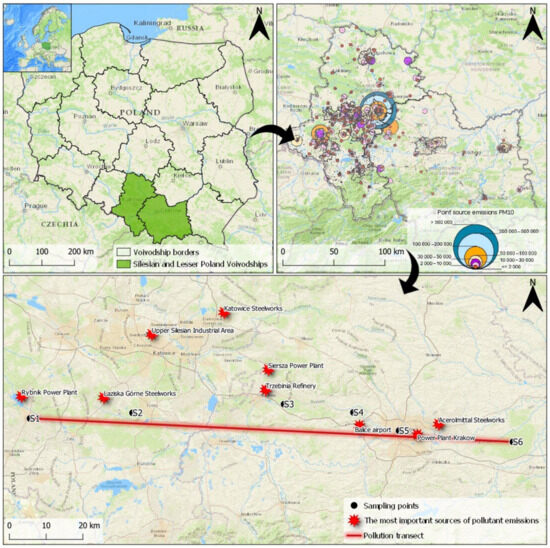
Figure 1.
Location of the sampling sites.
This area is the most industrialised geographical region in Poland [20] and is associated with the occurrence and exploitation of hard coal deposits for the energy industry. Most of the mines are located in the Upper Silesian Industrial Region, where there are also several coal-fired power plants, industrial factories and coking plants. Due to the high industrial intensity associated with the energy economy, the study area has been strongly influenced by pollution. The study area is also characterized by the densest level of agglomeration and population, which undoubtedly has a huge impact on air quality and pollutant emissions [21,22]. According to the Environmental Impact Report prepared for the Silesian Voivodeship [23] and the Lesser Poland Voivodeship [24], emissions from Upper Silesian Industrial Region plants account for 53% of the national emissions of gaseous pollutants (excluding carbon dioxide) and about 25% of the national emissions of dust. In 2013–2018, the average annual concentrations of inhalable particulate matter (PM10) exceeded the permissible standard of 40 μg∙m3 at stations in the Kraków Agglomeration and the City of Rybnik, among others. Exceedances of permissible values of daily concentrations of PM10 have occurred over the entire study area, most frequently in winter, and are mainly related to dust emissions originating from the heating of individual buildings. The annual average concentrations of benzo(a)pyrene (BaP) in PM10 at all stations in the Silesian and Lesser Poland Voivodeships have exceeded the target limit of 1 ng∙m3.
Test plots were selected based on field observations. Sample plots with equivalent soil types (Cambisols) and soil textures (sandy loam) were then selected for analysis [25]. The sampling sites were located in stands of coniferous monocultures formed by Scots pine (Pinus sylvestris). The stands were all 80 years old. A 150 km long transect was chosen, containing six sampling sites, with their average distances being about 30 km from each other. The transect ran through areas with the highest concentrations of industrial pollutants in both commercial and urban forest zones (Figure 1). Six study plots were designated at each site. From all locations along the transect, a total of 25 soil samples were collected. In location S1, 3 replicates of soil samples were collected, while locations S2, S3, and S5 contained 6 replicates each. Locations S4 and S6 had 2 replicates of each sample. Samples were taken from the 0 to 10 cm horizon, after removal of the organic horizon.
2.2. Laboratory Analysis
For analysis of the PAH content, naturally moist, fresh samples were sieved (2 mm mesh) and stored in the dark at 4 °C prior to analysis. To determine the PAH compounds, 10 g of each soil sample were extracted using 70 mL of 2-propanol. These samples were then centrifuged (4500 rpm, 5 min) and the supernatants were collected and subjected to solid-phase extraction (5 mL·min−1) using a CHROMABOND CN/SiOH column. The resulting residues were dissolved in acetonitrile and analysed by high-pressure liquid chromatography (HPLC) using a Dionex UltiMate 3000 HPLC system equipped with a fluorescence detector and a Dionex UltiMate 3000 Column Compartment C18 5 μm with a 4.6·100 mm HPLC column. The mobile phases were water (A) and acetonitrile (B) at a flow rate of 1 mL·min−1. Calibration solutions of different concentrations (0.1, 0.2, 0.5, 1 and 2 μg·mL−1) were prepared based on a PAH calibration-mixture standard (CRM 47940) of 10 μg·mL−1. The prepared solutions were placed in a chromatographic column, with the obtained chromatograms used to prepare a calibration curve. The soil samples were then analysed in triplicate. After every ninth analysis, a control sample (calibration solution of 0.1 μg·mL−1) was injected. The concentrations of naphthalene (Nft), acenaphthene (Ace), fluorene (Flu), phenanthrene (Phe), anthracene (Ant), fluoranthene (Flt), pyrene (Pyr), benzo(a)anthracene (BaA), chrysene (Chr), benzo(k)fluoranthene (BkF), benzo(b)fluoranthene (BbF), benzo(a)pyrene (BaP), dibenzo(ah)anthracene (DahA), indeno(1,2,3-c,d)pyrene (IcdP) and benzo(g,h,i)perylene (BghiP) were measured.
2.3. Toxicity Equivalent Quotient
Calculation of the toxicity equivalent quotients (TEQs) of the PAHs relative to BaP was used to determine an ecological risk assessment of the PAHs. This method is often used in aquatic environments, soils and sediments [26,27,28]. Seven toxic PAHs (BkF, BaP, BbF, Chr, BaA, IcdP and DahA) were considered for the calculations, based on the US Environmental Protection Agency (USEPA) protocol [29]. The formula used is as follows:
The lowest risk concentration of BaP was converted to a TEQ of 0.0005 μg∙kg−1 (TEQQV) [30] to more clearly represent the risk level derived from the TEQCARC value. The risk classification is shown in Table 1.

Table 1.
Risk levels for toxicity equivalent quotient (TEQ).
2.4. Assessment of the Toxicity of PAHs in Soils
PAHs can be absorbed by humans through the skin and respiratory tract and can cause skin and lung cancer, among other diseases. Long-term exposure to PAHs in the environment can cause a number of carcinogenic processes in humans. Toxic equivalency factors (TEFs) have been used to estimate the risk of exposure to individual and all PAHs to human health. BaP equivalent concentrations (BaPeq) were used to determine the toxicity at each site along the transect, and the TEFs for all 16 PAHs were selected and calculated according to the USEPA [29] and Nisbet and LaGoy guidelines [31]. The total BaPeqs were calculated using the following equation:
where Ci is a single PAH concentration and TEFi is the relevant TEF.
2.5. Potential Ecological Risk Assessment
Plants and aquatic environments are potentially at risk from PAH toxins that accumulate in the soil. A risk quotient (RQ) has been used to determine the risk of harmful PAH substances [32]. To calculate the ecological risk of the PAHs in the soil, qualitative values for the average of negligible concentrations (NCs) and maximum permissible concentrations (MPCs) were used. With these, the RQ(NCs) and RQ(MPCs) could be determined, as follows:
where RQ(NCs) is the lowest RQ, RQ(MPCs) is the highest RQ, C(PAHs) is the exposure concentration of an individual PAH, CQV(NCs) is the lowest average risk value for the PAH, CQV(MPCs) is the highest risk value for the PAH, and ΣPAHs is the sum of the RQ values for all 16 PAHs. Table 2 provides the minimum and maximum standard values for individual PAHs, whilst Table 3 gives the ecological risk criteria for the individual PAHs and ΣPAHs.

Table 2.
Lowest and highest risk standard values for PAHs.

Table 3.
Risk quotient levels for individual PAHs and the sum of PAHs.
2.6. Incremental Lifetime Cancer Risk Ratio
The main routes of human exposure to soil-related toxic PAH compounds are soil ingestion, inhalation and dermal contact. The incremental lifetime cancer risk (ILCR) ratio provides an estimate of the potential cancer risk to humans [33,34]. The cancer risk for the three pathways was calculated according to the equations [35]:
where ILCRingestion, ILCRinhalation and ILCRdermal are the ILCRs associated with the exposure pathways of ingestion, inhalation and dermal contact, respectively, Csoil represents the TEQ concentrations of the PAHs in soil, IR and HR are the ingestion rate (mg∙d−1) and air inhalation rate (m3∙d−1), respectively, ED is the exposure duration (yr), EF is the exposure frequency (d∙yr−1), BW is the body weight, AT is the average time (d), PEF is the particle emission factor (m3∙kg−1), SA is the surface area of the skin (cm2∙d−1), AF is the relative skin adherence factor (mg∙cm−2), ABS is the dermal absorption factor, and CSFingestion, CSFinhalation and CSFdermal are the cancer risk slope factors for BaP via the different pathways (mg∙kg−1∙d−1). The total cancer risk is assumed to be the sum of the three different pathways [35,36,37,38]:
Table 4 provides the cancer risk parameters for evaluating dermal and ingestion exposure.

Table 4.
Factors in the incremental lifetime cancer risk ratio (ILCR).
2.7. Diagnostic Indicators for the Identification of Sources of PAH Pollution Emissions
In this study, PAH diagnostic indicators determined the type of biomass combustion used in the energy-production process [Flt/(Flt + Pyr); BaA/(BaA + Chr); IcdP/(IcdP + BghiP)] [39,40,41] differentiated the origin of the pollutants resulting from transport traffic (BaP/BghiP) [42] and were used to distinguish the different sources of PAH emissions along the transect (Table 5).

Table 5.
Indicators defining the sources of PAH emissions.
2.8. Statistical Analysis
ANOVA was used to assess significant differences between the mean values of the properties. The relationship between the properties was established using Pearson’s coefficient. Principal component analysis (PCA) was used to interpret factors in certain datasets. Agglomeration of the localisation into groups that differed in PAH content was performed based on Ward’s method [43]. All statistical analyses were performed using R [44] and R Studio software (2020 version, PBC: Boston, MA, USA) [45]. Surfer 15 software (Version 15, LLC: Golden, CO, USA) [46] was used to express spatial variability and to generate maps of the studied indicators, and the kriging interpolation method was used to generate the maps.
3. Results
There was a differentiation of the PAH contents in the soils of the studied transect (Table 1). On average, the highest number of PAHs (average total = 52.75 μg·kg−1) occurred in the soils from Site S1 (city forests in Rybnik). Significantly high PAH contents (mean sums = 47.13 and 44.67 μg·kg−1, respectively) were also noted at Sites S2 and S3. Significantly lower PAH contents (mean sums = 12.49 and 12.41 μg·kg−1, respectively) were recorded in the forest areas around Kraków at Sites S4 and S6. In the soils of Kraków’s urban forests, the PAH contents did not differ significantly from the other sites (Table 6). Among the determined PAHs, the most numerous in the soils were Flu, Flt, Pyr and Chr, whilst the least numerous were Nft and Ace. The differences in the PAH contents depended on the number of benzene rings, as shown in Figure 2. Four- and five-ring PAHs were dominant in the studied soils. The highest number of four-ring PAHs was recorded in the soils of Kraków and its vicinity (Sites S4–S6), and the lowest in the soils of Site S3. The highest number of five-ring PAHs was recorded in the soils of Site S3, and the least in the soils of the forests in Rybnik and its vicinity (Sites S1 and S2) (Figure 2). The share of six-ring PAHs ranged from a few to a dozen or so percent, with the most recorded in the soils at Sites S2 and S3.

Table 6.
Content of individual PAHs (μg·kg−1) in the tested soils.
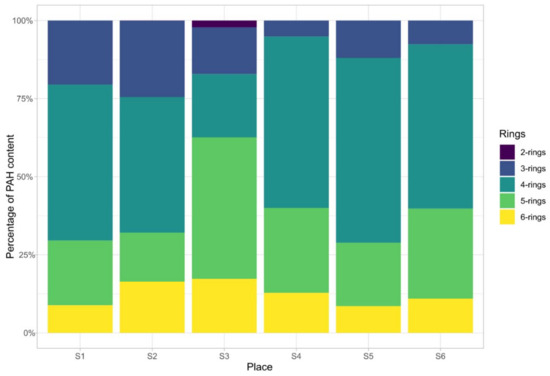
Figure 2.
Mean percentage of individual PAHs in relation to the study plots.
The ecological risks of the PAHs, expressed as the TEQs, differentiated the soils of the studied sites. The soils of Site S3 had a moderate-to-high risk, whilst the risk was low-to-moderate at other sites (Figure 3, Table 3). The BaPeqs also were distinct in the soils at the different sites, with the highest recorded at S3, whilst S1 and S2 were characterised by lower, but still high, BaPeqs (Figure 3).
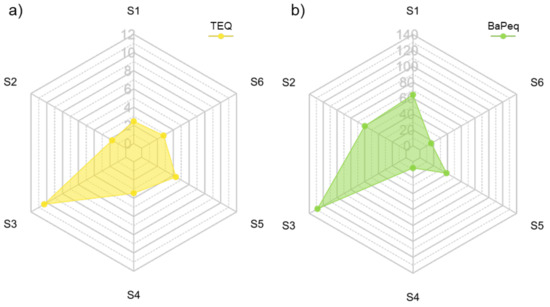
Figure 3.
TEQ (a) and BaPeq (b) values of different sampling sites.
The lowest BaPeq was recorded in the vicinity of Kraków in the soils at Sites S4 and S6. The RQs, used to determine the risk of harmful PAH substances, were strongly differentiated in the soils of the disparate sites (Figure 4 and Figure 5), but with the highest values of RQ(NCs) and RQ(MPCs) indicating high risk in the soils at all sites. The highest RQ(NCs) and RQ(MPCs) values were recorded in the soils of Sites S1, S2 and S3 (Figure 4 and Figure 5). However, a very low cancer potential, relative to the adult ILCR index, was determined for Site S4, where it was 6.21 × 10−6. At Sites S1, S2, S5 and S6, the results were within the low-risk range, scoring 4.86 × 10−5, 3.87 × 10−5, 3.06 × 10−5 and 1.30 × 10−5, respectively (Figure 6).
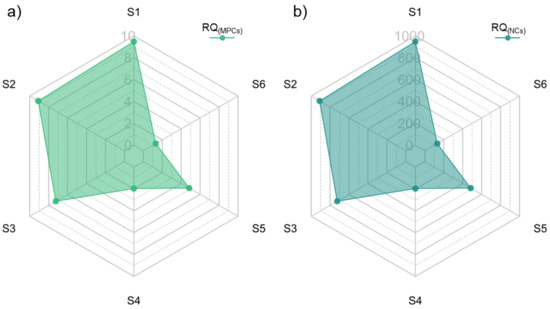
Figure 4.
Lowest RQ(MPCs) (a) and highest risk RQ(NCs) (b) quotient values of different sampling sites.
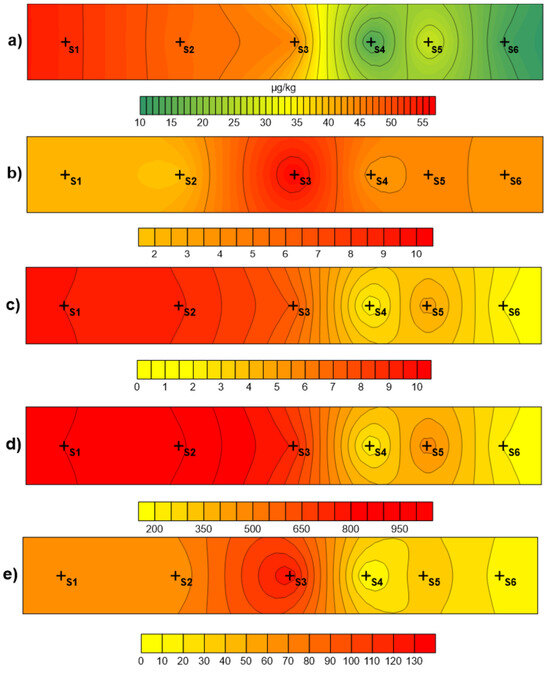
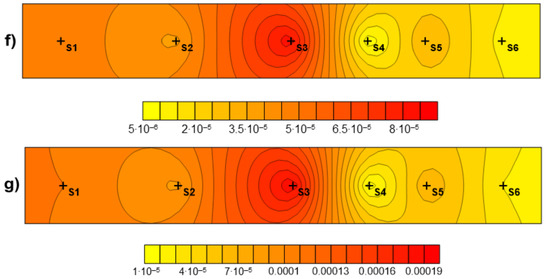
Figure 5.
Maps of spatial distribution of (a) average PAH contamination; (b) TEQ value; (c) RQ(NCs) (d) RQ(MPCs); (e) BaP equivalent; (f) ILCR adult; (g) ILCR children.
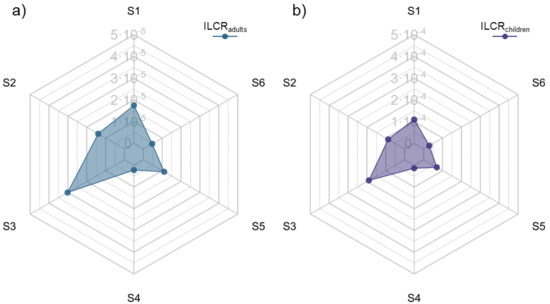
Figure 6.
Incremental lifetime cancer risk ratios (ILCR) for adults (a) and children (b).
Site S3 had the highest recorded risk, at 8.38 × 10−5, which places it closest to the moderate risk category of the ILCR index. By contrast, the ILCR index for children at Sites S1 and S3 reached the moderate risk category, with scores of 1.1 × 10−4 and 1.9 × 10−4, respectively. The remaining sites (S2, S4, S5 and S6) scored 8.76 × 10−5, 1.41 × 10−5, 6.94 × 10−5 and 2.95 × 10−5, respectively, thus falling in the low-risk range. In order to identify the sources of the PAHs, we used four diagnostic ratios. A comparison of the coefficients that determined the sources of the PAHs showed that the cause of soil contamination in all variants was mixed, with Figure 7 showing that the share of pollutants in the soils was affected by industrial combustion, biomass and coal combustion, and traffic emissions. The grouping analysis, performed using the RQ, BaPeq, TEQ and ILCR ratio values, confirmed the distinctiveness of the soils from Sites S1–S3 and S4–S6 (Figure 8).
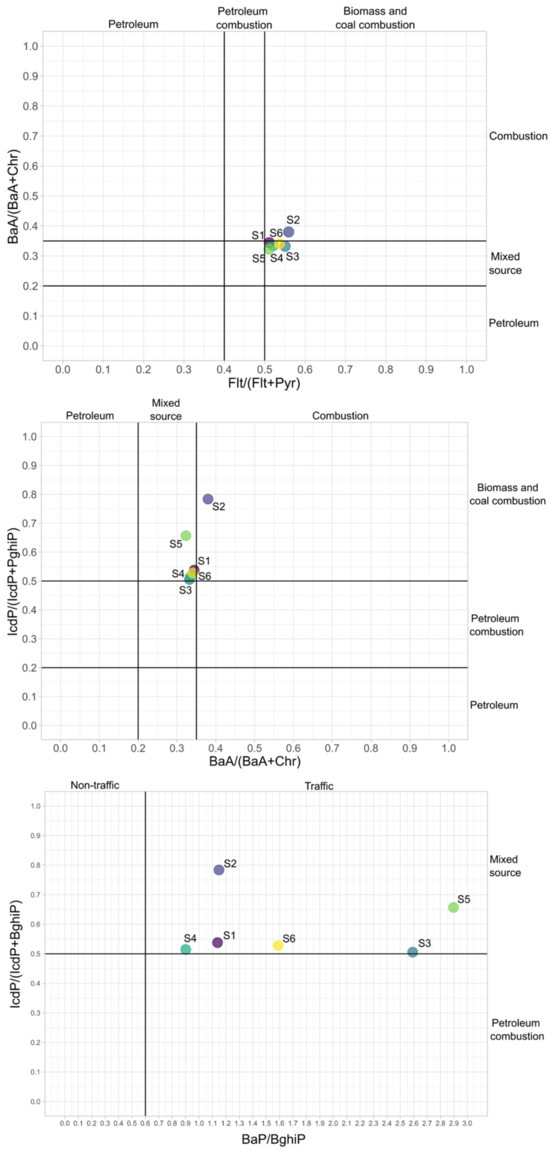
Figure 7.
Diagnostic coefficients of PAH sources at different study sites.

Figure 8.
Dendrogram comparing the ecological risk potential (RQ), total toxicity equivalent concentrations (BaPeq), toxicity equivalent quotient (TEQ) and incremental lifetime cancer risk ratio (ILCR) of the studied soils.
Factors 1 and 2, distinguished by the PCA for the organic horizons, explained a total of 68.8% of the variance in the soil characteristics (Figure 9). The PCA also confirmed the distinctiveness of the soils, indicating that S3 was distinct from the others. Factor 1 was mainly related to the risk assessment indicators, while Factor 2 was related to the indicators that identified the source of pollution (Figure 9).
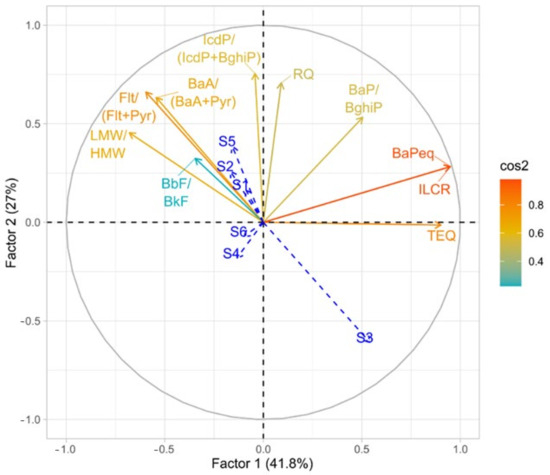
Figure 9.
Projection of the variables on the factor plane.
4. Discussion
The PAH concentrations in the forest soil samples of the studied transect were compared with those from other Europe regions. This comparison revealed that the studied soils had relatively low PAH concentrations compared to the other regions. From this study, the mean sums of the PAHs ranged from 12.41 to 52.76 μg·kg−1, whilst the sum of 16 PAH concentrations from the topmost 2 cm of forest soils from a north–south transect through the city of Oslo had a maximum value of 2.6 mg·kg−1 dm [47]. According to Aichner et al. [48], the sum of 16 EPA-PAH concentrations from German forest soils ranged from 105 to 14.889 ng·g−1 dw in the O horizon [49], and from 20 to 9038 and from 7 to 4424 ng·g−1 dw in the mineral topsoil (0–5 cm and 5–10 cm, respectively). The sum of 16 PAH concentrations in soils from London ranged from 4 to 66 mg·kg−1, with a mean of 18 mg/kg and a median of 14 mg·kg−1 [50]. The PAH distribution patterns showed that four- and five-ring PAH compounds dominated, whereas two- and three-ring PAH compounds were barely present at all. From the group of four-ring PAHs, the Flt, Pyr, BaA and Chr contents were determined. In this study, Flt, Pyr and Chr were present in the highest amounts. The BbF, BaP, IcdP and DahA contents were determined from the group of five- and six-ring PAHs. Hydrocarbons with fewer rings degrade faster than those with more, and PAHs are subject to various chemical reactions, including oxidation, reduction and electrophilic substitution. Although PAHs are relatively permanent compounds, they undergo reconstruction, for example, under the influence of thermal factors. In terms of environmental protection, oxidation reactions are important in the process of PAH degradation in the environment [51]. Hydrocarbons with a smaller number of rings in the molecule undergo faster microbial decomposition, which in turn leads to the undesirable accumulation of more harmful PAHs (with a greater number of rings) in the soil [52]. It should be understood that PAHs never occur individually in the environment, which means that a high concentration of one compound from this group indicates a high level for others as well, as was confirmed in our study.
The most contaminated soils from the studied transect were those from the Upper Silesian Industrial Region (Sites S1 and S2). This and the adjacent areas represent a critical example of the fabricated change of a natural system. The main cause of the catastrophic pollution of the Upper Silesian Industrial District is the excessive concentration of industry and mining, buildings and the corresponding development of communications and transport industries. The emission of PAHs into the environment from anthropogenic sources is several times higher here than the natural background emissions. It is believed that the combustion process is responsible for over 90% of the PAHs present in this environment [53], with the largest amount of PAHs entering the environment via the burning of fuels to heat homes and as a result of heavy-industry activities associated with the processing of coal and oil, mainly in the coke, petrochemical and metallurgy industries [54]. The forested area between Rybnik and Kraków had some of the highest 16-PAH concentrations. These high values can be explained by the predominant wind direction being towards the west, carrying PAHs from the Upper Silesian Industrial Region to the forest. However, more local sources, such as refineries and power plants, cannot be excluded. Our results show the emissions fingerprints of local and regional sources and suggest that these are major influencing factors in the composition of the PAHs in the study area. According to Wang et al. [19], the level of urbanisation corresponds very well to PAH accumulation in soils, although the main sources of the PAHs are different for different levels of urbanisation. The diagnostic indicators of PAH sources used in this study did not identify them unequivocally. In all cases, a mixed source of contamination was determined. Our analysis indicated that the share of pollutants in the soils was contributed to by industrial combustion, biomass and coal combustion, and traffic emissions. These findings may be related to the specificity of the studied transect, with the main cause of pollution in the region being industry and mining, communications and transport, and the fact that coal is still the dominant energy source in Poland [55].
The PAH risk assessment indicators employed herein were particularly useful for the forest soils, with the ecological risks of the PAHs found to be moderate-to-high. The highest risk was recorded in the soils at Sites S1–S3, in the Upper Silesian Industrial District or within its impact range. Earlier studies on the contamination of not only soil have indicated the utility of such risk assessment indicators [56,57]. Cancer risk is usually estimated using the ILCR index, which explains the increase in likelihood of developing cancer via pathways of exposure to potential carcinogenic compounds. The ILCR ratios based on the USEPA [28,35] and Li et al. [29] guidelines indicate that values below 10−6 represent very low risk, 10−6–10−4 represent low risk, 10−4–10−3 represent moderate risk and 10−3–10−1 represent high risk. According to Health Canada [58], the cancer risk is considered negligible if the estimated ILCR is 1 in 100,000 (i.e., ≤1 × 10−5), but if the ILCR ratio is greater than 1 × 10−5, risk management measures should be taken. Most of the sites in close proximity to the toxic emissions from the Silesian region fell within the 10−5–10−4 range, indicating low-to-moderate lifetime cancer risk. Close proximity to the deposition of pollutants from the Upper Silesian Industrial District and the harmful PAH emissions from the Trzebinia Refinery contributed to the high ILCR values near Sites S1–S3. Several studies have also confirmed the extremely harmful impacts of refineries as major centres of PAH emissions into the environment, including their effects on human health [59,60] which is why management measures are recommended where the ILCR index is greater than 10−5 [58]. Exposure to toxic PAH compounds can initiate carcinogenic processes that can have a decisive impact on the subsequent course of COVID-19 disease, highlighting the comorbidity factor [61,62]. Our findings suggest the need for further monitoring of the quality of urban and suburban forest environments. Current forecasts indicate that, in 2050, 69.6% of the world population will live in cities. For many people, migrating to large cities is associated with the need to adapt to life in a new anthropogenic environment and includes finding places to spend free time that is as close as possible to the city.
5. Conclusions
Our findings confirm the potential in applying risk assessment indicators to forest soils. Here, they were able to differentiate between the soils from the studied sites. The assessment indicated that PAHs have strongly contaminated the soils of the Upper Silesian Industrial Region and the area under its influence. Less pollution was recorded in soils from the urban forests of Kraków and the forests around this agglomeration. Differences related to the degree of urbanisation were clearly distinguishable along the studied transect. However, the diagnostic indicators were not as useful for identifying the sources of the PAHs in the forest soils. Our analysis indicated areas where the PAH content may pose a risk to people’s health, whilst the overall potential ecological risk of the soil PAHs was found to be high. As a result, the inhabitants of Rybnik and the surrounding area should consider spending their free time in forested areas somewhat removed from the Upper Silesian Industrial Region. It is clear that systematic and continuous PAH monitoring is necessary to keep people safe.
Author Contributions
Conceptualization, E.B. and J.L.; methodology, E.B., J.L. and S.Ł.; software, S.Ł.; validation, S.Ł. and E.B.; formal analysis, E.B., J.L. and S.Ł.; investigation, E.B. and S.Ł.; resources, E.B., J.L. and S.Ł.; data curation, E.B. and S.Ł.; writing—original draft preparation, E.B., J.L. and S.Ł.; writing—review and editing, E.B., J.L. and S.Ł.; visualization, S.Ł.; supervision, E.B. and S.Ł.; project administration, E.B. and S.Ł.; funding acquisition, E.B. and J.L. All authors have read and agreed to the published version of the manuscript.
Funding
Research for this paper was financed by a subvention from the Ministry of Science and Higher Education of the Republic of Poland for the University of Agriculture in Krakow for 2020 (SUB/040012/D019; A439).
Data Availability Statement
Data available on request from the authors.
Conflicts of Interest
The authors declare no conflicts of interest.
References
- Samuelsson, K.; Barthel, S.; Giusti, M.; Hartig, T. Visiting Nearby Natural Settings Supported Wellbeing during Sweden’s “Soft-Touch” Pandemic Restrictions. Landsc. Urban Plan. 2021, 214, 104176. [Google Scholar] [CrossRef]
- Da Schio, N.; Phillips, A.; Fransen, K.; Wolff, M.; Haase, D.; Ostoić, S.K.; De Vreese, R. The Impact of the COVID-19 Pandemic on the Use of and Attitudes towards Urban Forests and Green Spaces: Exploring the Instigators of Change in Belgium. Urban For. Urban Green. 2021, 65, 127305. [Google Scholar] [CrossRef] [PubMed]
- Weinbrenner, H.; Breithut, J.; Hebermehl, W.; Kaufmann, A.; Klinger, T.; Palm, T.; Wirth, K. “The Forest Has Become Our New Living Room”—The Critical Importance of Urban Forests During the COVID-19 Pandemic. Front. For. Glob. Change 2021, 4, 683. [Google Scholar] [CrossRef]
- Ghosal, D.; Ghosh, S.; Dutta, T.K.; Ahn, Y. Current State of Knowledge in Microbial Degradation of Polycyclic Aromatic Hydrocarbons (PAHs): A Review. Front. Microbiol. 2016, 7, 13691. [Google Scholar] [CrossRef] [PubMed]
- Cao, H.; Wang, C.; Liu, H.; Jia, W.; Sun, H. Enzyme Activities during Benzo[a]pyrene Degradation by the Fungus Lasiodiplodia theobromae Isolated from a Polluted Soil. Sci. Rep. 2020, 10, 865. [Google Scholar] [CrossRef] [PubMed]
- Tiwari, J.N.; Chaturvedi, P.; Ansari, N.G.; Patel, D.K.; Jain, S.K.; Murthy, R.C. Assessment of Polycyclic Aromatic Hydrocarbons (PAH) and Heavy Metals in the Vicinity of an Oil Refinery in India. Soil Sediment Contam. 2011, 20, 315–328. [Google Scholar] [CrossRef]
- Lui, K.H.; Chan, C.S.; Tian, L.; Ning, B.F.; Zhou, Y.; Song, X.; Ho, K.F. Elements in Fine Particulate Matter (PM2.5) from Indoor Air During Household Stoves Coal Combustion at Xuanwei, China. Aerosol Sci. Eng. 2017, 1, 41–50. [Google Scholar] [CrossRef]
- Wilcke, W. Synopsis polycyclic aromatic hydrocarbons (PAHs) in soil—A review. J. Plant Nutr. Soil Sci. 2000, 163, 229–248. [Google Scholar] [CrossRef]
- Dai, C.; Han, Y.; Duan, Y.; Lai, X.; Fu, R.; Liu, S.; Leong, H.L.; Yaojen, T.; Zhou, L. Review on the contamination and remediation of polycyclic aromatic hydrocarbons (PAHs) in coastal soil and sediments. Environ. Res. 2022, 205, 112423. [Google Scholar] [CrossRef]
- Li, H.; Lai, Z.; Zeng, Y.; Gao, Y.; Yang, W.; Mai, Y.; Wang, C. Occurrence, Source Identification, and Ecological Risk Assessment of Polycyclic Aromatic Hydrocarbons in Sediments of the Pearl River Delta, China. Mar. Pollut. Bull. 2021, 170, 112666. [Google Scholar] [CrossRef]
- Agarwal, T.; Khillare, P.S.; Shridhar, V.; Ray, S. Pattern, Sources and Toxic Potential of PAHs in the Agricultural Soils of Delhi, India. J. Hazard. Mater. 2009, 163, 1033–1039. [Google Scholar] [CrossRef]
- Liu, W.; Wang, D.; Wang, Y.; Zeng, X.; Ni, L.; Tao, Y.; Zhang, J. Improved Comprehensive Ecological Risk Assessment Method and Sensitivity Analysis of Polycyclic Aromatic Hydrocarbons (PAHs). Environ. Res. 2020, 187, 1095001. [Google Scholar] [CrossRef]
- Tobiszewski, M.; Namieśnik, J. PAH Diagnostic Ratios for the Identification of Pollution Emission Sources. Environ. Pollut. 2012, 162, 110–119. [Google Scholar] [CrossRef]
- Cachada, A.; Pato, P.; Rocha-Santos, T.; da Silva, E.F.; Duarte, A.C. Levels, Sources and Potential Human Health Risks of Organic Pollutants in Urban Soils. Sci. Total Environ. 2012, 430, 184–192. [Google Scholar] [CrossRef]
- Manoli, E.; Kouras, A.; Samara, C. Profile Analysis of Ambient and Source Emitted Particle-Bound Polycyclic Aromatic Hydrocarbons from Three Sites in Northern Greece. Chemosphere 2004, 56, 867–878. [Google Scholar] [CrossRef]
- Kendall, C.; Silva, S.R.; Kelly, V.J. Carbon and Nitrogen Isotopic Compositions of Particulate Organic Matter in Four Large River Systems across the United States. Hydrol. Process. 2001, 15, 1301–1346. [Google Scholar] [CrossRef]
- Haritash, A.K.; Kaushik, C.P.J. Biodegradation aspects of polycyclic aromatic hydrocarbons (PAHs): A review. Hazard. Mater. 2009, 169, 1–15. [Google Scholar] [CrossRef] [PubMed]
- Couto, M.N.P.; Monteiro, E.; Vasconcelos, M.T.S. Mesocosm trials of bioremediation of contaminated soil of a petroleum refinery: Comparison of natural attenuation, biostimulation and bioaugmentation. Environ. Sci. Pollut. Res. 2010, 17, 1339–1346. [Google Scholar] [CrossRef] [PubMed]
- Wang, X.T.; Miao, Y.; Zhang, Y.; Li, Y.C.; Wu, M.H.; Yu, G. Polycyclic Aromatic Hydrocarbons (PAHs) in Urban Soils of the Megacity Shanghai: Occurrence, Source Apportionment and Potential Human Health Risk. Sci. Total Environ. 2013, 447, 80–89. [Google Scholar] [CrossRef] [PubMed]
- EEA. Air Quality E-Reporting Database; European Environment Agency: Copenhagen, Denmark, 2020. Available online: http://discomap.eea.europa.eu/map/fme/AirQualityExport.htm (accessed on 6 March 2022).
- Fabiańska, M.J.; Kozielska, B.; Konieczyński, J.; Kowalski, A. Sources of organic pollution in particulate matter and soil of Silesian Agglomeration (Poland): Evidence from geochemical markers. Environ. Geochem. Health 2016, 38, 821–842. [Google Scholar] [CrossRef]
- Godzik, B. Use of Bioindication Methods in National, Regional and Local Monitoring in Poland—Changes in the Air Pollution Level over Several Decades. Atmosphere 2020, 11, 143. [Google Scholar] [CrossRef]
- The State of The Environment in the Silesian Voivodship; Chief Inspectorate for Environmental Protection, Department of Environmental Monitoring, Regional Department of Environmental Monitoring in Katowice: Katowice, Poland, 2020. Available online: https://www.gios.gov.pl/images/dokumenty/pms/raporty/stan_srodowiska_2020_slaskie.pdf (accessed on 6 March 2022).
- The State of The Environment in the Lesser Poland Voivodship; Chief Inspectorate for Environmental Protection, Department of Environmental Monitoring, Regional Department of Environmental Monitoring in Kraków: Kraków, Poland, 2020. Available online: https://www.gios.gov.pl/images/dokumenty/pms/raporty/stan_srodowiska_2020_malopolskie.pdf (accessed on 6 March 2022).
- IUSS Working Group WRB. World Reference Base for Soil Resources 2014, Update 2015: International Soil Classification System for Naming Soils and Creating Legends for Soil Maps. In World Soil Resources Reports No. 106; FAO: Rome, Italy, 2015. [Google Scholar]
- Van den Berg, M.; Birnbaum, L.S.; Denison, M.; De Vito, M.; Farland, W.; Feeley, M.; Fiedler, H.; Hakansson, H.; Hanberg, A.; Haws, L.; et al. The 2005 World Health Organization reevaluation of human and mammalian toxic equivalency factors for dioxins and dioxin-like compounds. Toxicol. Sci. 2006, 93, 223–241. [Google Scholar] [CrossRef]
- Tsai, W.T.; Mi, H.H.; Chang, J.H.; Chang, Y.M. Levels of Polycyclic Aromatic Hydrocarbons in the Bio-Oils from Induction-Heating Pyrolysis of Food-Processing Sewage Sludges. J. Anal. Appl. Pyrolysis 2009, 86, 364–368. [Google Scholar] [CrossRef]
- Li, G.; Lang, Y.; Yang, W.; Peng, P.; Wang, X. Source Contributions of PAHs and Toxicity in Reed Wetland Soils of Liaohe Estuary Using a CMB–TEQ Method. Sci. Total Environ. 2014, 490, 199–204. [Google Scholar] [CrossRef]
- United States Environmental Protection Agency (USEPA). Guidelines for Ecological Risk Assessment; Risk Assessment Forum, US Environmental Protection Agency: Washington, DC, USA, 1998; Volume 63, pp. 846–924.
- Chen, J.; Fan, B.; Li, J.; Wang, X.; Li, W.; Cui, L.; Liu, Z. Development of human health ambient water quality criteria of 12 polycyclic aromatic hydrocarbons (PAH) and risk assessment in China. Chemosphere 2020, 252, 126590. [Google Scholar] [CrossRef]
- Nisbet, I.C.; Lagoy, P.K. Toxic Equivalency Factors (TEFs) for Polycyclic Aromatic Hydrocarbons (PAHs). Regul. Toxicol. Pharmacol. 1992, 16, 290–300. [Google Scholar] [CrossRef]
- Kalf, D.F.; Crommentuijn, T.; van de Plassche, E.J. Environmental Quality Objectives for 10 Polycyclic Aromatic Hydrocarbons (PAHs). Ecotoxicol. Environ. Saf. 1997, 36, 89–97. [Google Scholar] [CrossRef] [PubMed]
- US EPA. Supplemental Guidance for Developing Soil Screening Levels for Superfund Sites; OSWER, 2002 [9355.4-24]; US EPA: Washington, DC, USA, 2002.
- Liu, G.R.; Peng, X.; Wang, R.K.; Tian, Y.Z.; Shi, G.L.; Wu, J.H.; Feng, Y.C. A New Receptor Model-Incremental Lifetime Cancer Risk Method to Quantify the Carcinogenic Risks Associated with Sources of Particle-Bound Polycyclic Aromatic Hydrocarbons from Chengdu in China. J. Hazard. Mater. 2015, 283, 462–468. [Google Scholar] [CrossRef] [PubMed]
- US EPA. Human Health Risk Assessment: Risk-Based Concentration Table; US EPA: Washington, DC, USA, 2015. Available online: https://www.epa.gov/sites/default/files/2015-10/documents/strap_2016_hhra_508.pdf (accessed on 6 March 2022).
- U.S. Environmental Protection Agency. Risk Assessment Guidance for Superfund Volume I: Human Health Evaluation Manual (Part E); U.S. Environmental Protection Agency: Washington, DC, USA, 2004.
- U.S. Environmental Protection Agency. Screening Level (RSL) for Chemical Contaminants at Superfund Sites; U.S. Environmental Protection Agency: Washington, DC, USA, 2011.
- U.S. Environmental Protection Agency. Human Health Evaluation Manual, Supplemental Guidance: Update of Standard Default Exposure Factors [Online]; U.S. Environmental Protection Agency, Office of Solid Waste and Emergency Response: Washington, DC, USA, 2014. Available online: https://nepis.epa.gov/Exe/ZyNET.exe/P100NQNA.TXT?ZyActionD=ZyDocument&Client=EPA&Index=2011+Thru+2015&Docs=&Query=&Time=&EndTime=&SearchMethod=1&TocRestrict=n&Toc=&TocEntry=&QField=&QFieldYear=&QFieldMonth=&QFieldDay=&IntQFieldOp=0&ExtQFieldOp=0&XmlQuery=&File=D%3A%5Czyfiles%5CIndex%20Data%5C11thru15%5CTxt%5C00000018%5CP100NQNA.txt&User=ANONYMOUS&Password=anonymous&SortMethod=h%7C-&MaximumDocuments=1&FuzzyDegree=0&ImageQuality=r75g8/r75g8/x150y150g16/i425&Display=hpfr&DefSeekPage=x&SearchBack=ZyActionL&Back=ZyActionS&BackDesc=Results%20page&MaximumPages=1&ZyEntry=1&SeekPage=x&ZyPURL (accessed on 6 March 2022).
- Yunker, M.B.; Macdonald, R.W.; Vingarzan, R.; Mitchell, R.H.; Goyette, D.; Sylvestre, S. PAHs in the Fraser River Basin: A Critical Appraisal of PAH Ratios as Indicators of PAH Source and Composition. Org. Geochem. 2002, 33, 489–515. [Google Scholar] [CrossRef]
- De La Torre-Roche, R.J.; Lee, W.-Y.; Campos-Díaz, S.I. Soil-Borne Polycyclic Aromatic Hydrocarbons in El Paso, Texas: Analysis of a Potential Problem in the United States/Mexico Border Region. J. Hazard. Mater. 2009, 163, 946–958. [Google Scholar] [CrossRef]
- Akyüz, M.; Çabuk, H. Gas–Particle Partitioning and Seasonal Variation of Polycyclic Aromatic Hydrocarbons in the Atmosphere of Zonguldak, Turkey. Sci. Total Environ. 2010, 408, 5550–5558. [Google Scholar] [CrossRef]
- Katsoyiannis, A.; Terzi, E.; Cai, Q.Y. On the Use of PAH Molecular Diagnostic Ratios in Sewage Sludge for the Understanding of the PAH Sources. Is This Use Appropriate? Chemosphere 2007, 69, 1337–1339. [Google Scholar] [CrossRef]
- Everitt, B.S. Cluster Analysis, 2nd ed.; Garner: London, UK, 1980. [Google Scholar]
- R Core Team. R: A Language and Environment for Statistical Computing [Online]; R Foundation for Statistical Computing: Vienna, Austria, 2020; Available online: http://www.R-project.org (accessed on 6 March 2022).
- RStudio Team. RStudio: Integrated Development for R [Online]; RStudio, PBC: Boston, MA, USA, 2020; Available online: http://www.rstudio.com (accessed on 6 March 2022).
- Golden Software, LLC. Surfer, Version 15; Golden Software, LLC: Golden, CO, USA, 2015.
- Jensen, H.; Reimann, C.; Finne, T.E.; Ottesen, R.T.; Arnoldussen, A. PAH-Concentrations and Compositions in the Top 2 cm of Forest Soils along a 120 km Long Transect through Agricultural Areas, Forests and the City of Oslo, Norway. Environ. Pollut. 2007, 145, 829–838. [Google Scholar] [CrossRef]
- Aichner, B.; Bussian, B.M.; Lehnik-Habrink, P.; Hein, S. Regionalized Concentrations and Fingerprints of Polycyclic Aromatic Hydrocarbons (PAHs) in German Forest Soils. Environ. Pollut. 2015, 203, 31–39. [Google Scholar] [CrossRef] [PubMed]
- Aichner, B.; Bussian, B.; Lehnik-Habrink, P.; Hein, S. Levels and Spatial Distribution of Persistent Organic Pollutants in the Environment: A Case Study of German Forest Soils. Environ. Sci. Technol. 2013, 47, 12703–12714. [Google Scholar] [CrossRef]
- Vane, C.H.; Kim, A.W.; Beriro, D.J.; Cave, M.R.; Knights, K.; Moss-Hayes, V.; Nathanail, P.C. Polycyclic Aromatic Hydrocarbons (PAH) and Polychlorinated Biphenyls (PCB) in Urban Soils of Greater London, UK. Appl. Geochem. 2014, 51, 303–314. [Google Scholar] [CrossRef]
- Łyszczarz, S.; Lasota, J.; Staszel, K.; Błońska, E. Effect of Forest and Agricultural Land Use on the Accumulation of Polycyclic Aromatic Hydrocarbons in Relation to Soil Properties and Possible Pollution Sources. For. Ecol. Manag. 2021, 490, 119105. [Google Scholar] [CrossRef]
- Łyszczarz, S.; Lasota, J.; Błońska, E. Polycyclic Aromatic Hydrocarbons (PAHs) Accumulation in Soil Horizons of Different Temperate Forest Stands. Land Degrad. Dev. 2021, 33, 945–959. [Google Scholar] [CrossRef]
- Bojakowska, I. Characteristic of Polycyclic Aromatic Hydrocarbons and Their Occurrence in Environment. Bull. Natl. Geol. Inst. 2003, 405, 5–28. [Google Scholar]
- Howsam, M.; Iones, K. Sources of PAHs in the Environment. In PAHs and Related Compounds: Chemistry; Neilson, A.H., Ed.; Springer: Berlin/Heidelberg, Germany, 1998; pp. 137–174. [Google Scholar]
- Maliszewska-Kordybach, B.; Smreczak, B.; Klimkowicz-Pawlas, A.; Terelak, H. Monitoring of the Total Content of Polycyclic Aromatic Hydrocarbons (PAHs) in Arable Soils in Poland. Chemosphere 2008, 73, 1284–1291. [Google Scholar] [CrossRef]
- Li, Y.; Wang, X.; Gong, P. Combined Risk Assessment Method Based on Spatial Interaction: A Case for Polycyclic Aromatic Hydrocarbons and Heavy Metals in Taihu Lake Sediments. J. Clean. Prod. 2021, 328, 129590. [Google Scholar] [CrossRef]
- Zhao, Y.; Li, J.; Qi, Y.; Guan, X.; Zhao, C.; Wang, H.; He, J. Distribution, Sources, and Ecological Risk Assessment of Polycyclic Aromatic Hydrocarbons (PAHs) in the Tidal Creek Water of Coastal Tidal Flats in the Yellow River Delta, China. Mar. Pollut. Bull. 2021, 173, 113110. [Google Scholar] [CrossRef]
- Health Canada. Federal Contaminated Site Risk Assessment in Canada Part I: Guidance on Human Health Preliminary Quantitative Risk Assessment (PQRA); Cat. H46-2/04-367E; Health Canada: Ottawa, ON, Canada, 2004; ISBN 0-662-38244-7. Available online: https://abandoned-mines.org/pdfs/RiskAssessmentWorkshop2008-pdfs/humanhealth-healthcanada.pdf (accessed on 6 March 2022).
- Kang, F.; Mao, X.; Wang, X.; Wang, J.; Yang, B.; Gao, Y. Sources and Health Risks of Polycyclic Aromatic Hydrocarbons during Haze Days in Eastern China: A 1-Year Case Study in Nanjing City. Ecotoxicol. Environ. Saf. 2017, 140, 76–83. [Google Scholar] [CrossRef] [PubMed]
- Han, F.; Guo, H.; Hu, J.; Zhang, J.; Ying, Q.; Zhang, H. Sources and Health Risks of Ambient Polycyclic Aromatic Hydrocarbons in China. Sci. Total Environ. 2020, 698, 134229. [Google Scholar] [CrossRef] [PubMed]
- Adly, H.M.; Saleh, S.A.K. Evaluation of Carcinogenic Polyaromatic Hydrocarbon Levels in Airborne Particulates Associated with Long-Term Exposure throughout the COVID-19 Pandemic in Makkah, Saudi Arabia. Int. J. Environ. Res. Public Health 2021, 18, 127451. [Google Scholar] [CrossRef] [PubMed]
- Anand, U.; Bianco, F.; Suresh, S.; Tripathi, V.; Núñez-Delgado, A.; Race, M. SARS-CoV-2 and Other Viruses in Soil: An Environmental Outlook. Environ. Res. 2021, 198, 111297. [Google Scholar] [CrossRef]
Disclaimer/Publisher’s Note: The statements, opinions and data contained in all publications are solely those of the individual author(s) and contributor(s) and not of MDPI and/or the editor(s). MDPI and/or the editor(s) disclaim responsibility for any injury to people or property resulting from any ideas, methods, instructions or products referred to in the content. |
© 2024 by the authors. Licensee MDPI, Basel, Switzerland. This article is an open access article distributed under the terms and conditions of the Creative Commons Attribution (CC BY) license (https://creativecommons.org/licenses/by/4.0/).